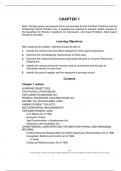Samenvatting
Summary Stress, Health and Disease (Sapolsky + 4 chapters from reader) (ISBN: )
- Instelling
- Universiteit Leiden (UL)
In this document you will find a summary of 'Why Zebras Don't get Ulcers, Sapolsky, 2004 (third edition) (ISBN: 3690) The book and the reader are used in the course Stress, Health and Disease (Second year, first block). The chapters summarized are: Chapter 1-9, 12, 13, 15, 17, 18 + chapter 1-4 (all...
[Meer zien]














